 Are you wondering what the changing social trends are for consumers?
Are you wondering what the changing social trends are for consumers?
If so, look no further.
In Nielsen and McKinsey's Social Media Report, consumers were surveyed to discover how they use social networks.
Here are seven key findings from that report.
#1: More Time Invested in Mobile
The survey found that consumers are increasingly looking to their smartphones and tablets to access social media.
While the PC is still the most widely used device when it comes to social media consumption, the study found that time spent on mobile apps and mobile websites accounted for a 63% increase (compared to 2011) in total time spent.
Additionally, 43% of users said they use smartphones to access social media, while 16% connect using a tablet.
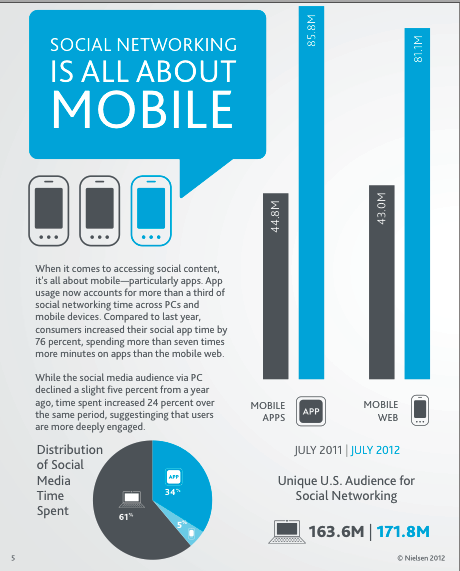
Key Takeaway: When it comes to consuming social content, it's all about mobile. For marketers, that means that mobile has to be your top content priority this year.
If you haven't done so already, here are some ideas to get you started:
- Set up a mobile website (there's a free WordPress plugin for this)
- Register your business on location-based services such as Foursquare, WHERE or SCVNGR
- Use SMS and MMS to attract customers
- Build your own app (even if you're not a developer) using GENWI, Mippin, MobiCart or ShoutEm
- Get more mobile marketing tips in Jamie Turner's excellent book, Go Mobile!
#2: Pinterest Usage Continues to Rise
Pinterest continues to experience exponential growth since its launch in 2011. The platform had the highest increase in audience and time spent of any social network across all devices such as PC, mobile web and apps.
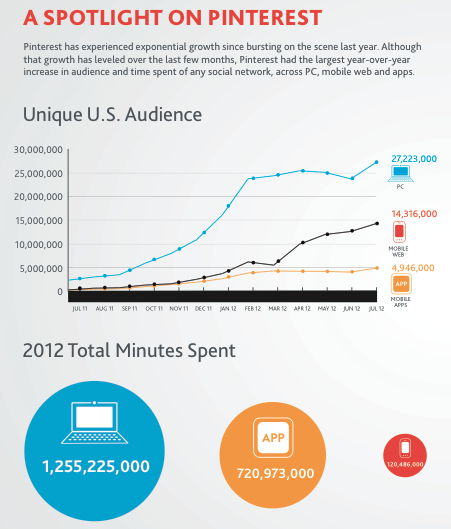
In addition, a May 2012 Harvard Business Review article titled, “Moving customers from pinning to purchase,” states that:
“Pinterest users reported a surprisingly high correlation between pinning and subsequent purchasing: more than 1 in 5 Pinterest users has pinned an item that they later purchased. In the social world, this is a high conversion rate.”
Key Takeaway: As a marketer, remember that product photography is more important than ever when trying to persuade Pinterest shoppers to pin and buy your hottest-looking items. Capitalize on their shopping experience and make your profile as creative and visually engaging as possible.
Get World-Class Marketing Training — All Year Long!
Are you facing doubt, uncertainty, or overwhelm? The Social Media Marketing Society can help.
Each month, you’ll receive training from trusted marketing experts, covering everything from AI to organic social marketing. When you join, you’ll also get immediate access to:
- A library of 100+ marketing trainings
- A community of like-minded marketers
- Monthly online community meetups
- Relevant news and trends updates
Also, don't forget to engage with people who have pinned your items to see if you could nudge them into buying something!
#3: Social Networking Generates Positive Sentiments
One of the most interesting findings in this survey was that 76% of participants said they experienced positive feelings after engaging in social networking.
Some of the words used to describe how they felt were: informed, energized, excited, connected and amused. However, 21% reported negative sentiments after social networking; examples are overwhelmed, anxious and wasted time. 24% remained neutral.
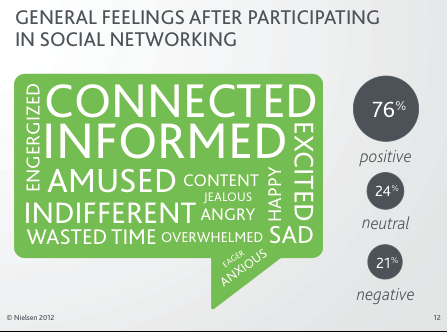
Key Takeaway: Social media is saturated with sentiment-rich data. Every update, tweet, blog comment or online review is a critical source of data that can inform your CRM program. As a marketer, you should be very interested in gathering and analyzing sentiment data to see if your social messages are producing the desirable outcomes you're looking for.

Discover Proven Marketing Strategies and Tips
Want to go even deeper with your marketing? Check out the Social Media Marketing Podcast! Publishing weekly since 2012, the Social Media Marketing Podcast helps you navigate the constantly changing marketing jungle, with expert interviews from marketing pros.
But don’t let the name fool you. This show is about a lot more than just social media marketing. With over 600 episodes and millions of downloads each year, this show has been a trusted source for marketers for well over a decade.
#4: Twitter Drives Social TV
Twitter has emerged as the most powerful driver of ‘social TV' interaction. That means when people are watching the Super Bowl, American Idol or the elections, they are simultaneously using Twitter to share their thoughts and experiences with friends.
In June 2012, a third of active Twitter users tweeted about TV-related content, which was up from 26% at the beginning of the year.
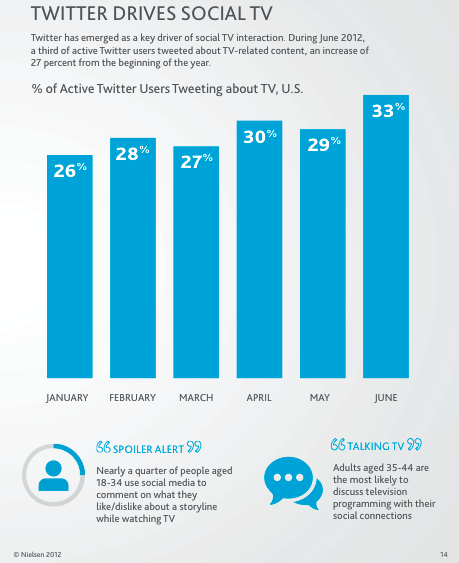
Key Takeaway: Social TV is still a new concept for marketers. However, considering that an average of 43 minutes are spent each day watching TV (HubSpot), and that many of those viewers are then sharing their experiences online, marketers should find ways to align any TV advertising with their online strategies (e.g., incorporating hashtags or tweetable sound bites in their TV commercials). This prolongs the conversation about brands beyond the TV, while allowing for extended word-of-mouth marketing.
#5: Social Care is the New Customer Care
Social care is a way for companies to provide regular customer service through social media platforms. The study revealed that one in three social media users prefers social care to contacting a company by phone.
Consumers use a variety of channels for social care. For example, they are most likely to comment or ask a question about a company's products or services on the company's Facebook page (29%), on their own personal Facebook profile (28%), on official company blogs (15%), on Twitter (personal handle – no mention of company, 14%) and on Twitter (company's handle, 13%).
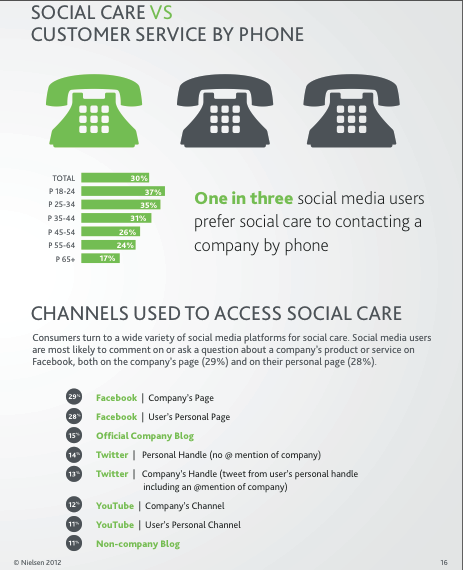
Key Takeaway: Social media has conditioned consumers to get immediate feedback. As a marketer, the risk of failing to meet such high expectations is not just losing customers, but having negative comments about your brand blasted around the user's network and their friends' networks. If you can get social care right, you will create a wide gap between your brand and your competition.
#6: Mixed Feelings about Social Ads
Another interesting finding was how people react to social ads. While 33% of people surveyed find ads on social networks to be annoying, 26% are more likely to pay attention to an ad posted by a friend.
Generally a Like is the most common action taken after seeing a social ad (26%), followed by a share (15%) and a product purchase (14%). As far as demographics go, the study found that Asian-American consumers were the most likely to respond positively to social ads, while white consumers were the most likely to be turned off by social media advertising.

Key Takeaway: Because advertising on social media is more annoying than other digital areas, marketers should proceed with caution and make sure their ads are highly relevant and targeted. On the bright side, many people don't mind social ads if they're tailored to suit personal tastes and interests. This presents a great opportunity for marketers to raise brand visibility.
#7: Social Listening a Key Consumer Activity
Social media is transforming the way consumers around the globe make purchasing decisions. Consumers are using social media to listen and learn about other consumers' experiences (70%); find more information about brands, products and services (65%); and compliment brands (53%).
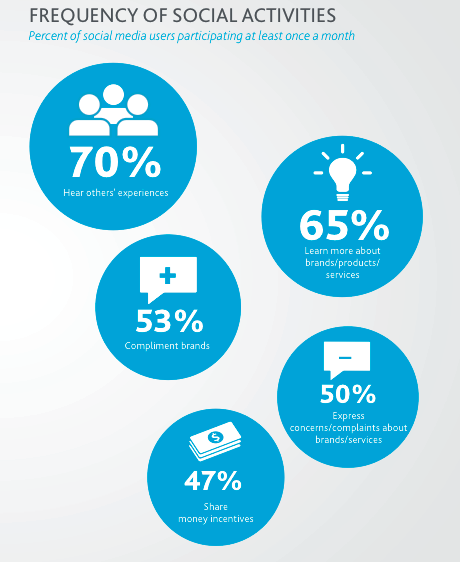
Key takeaway: We tend to think of social listening as something only marketers and research analysts do. However, it's interesting to see that consumers are also active listeners. This is an opportunity for marketers to educate consumers through compelling content, improve customer experiences (using social care) and maintain strong customer relationships to uphold a positive brand image.
Your Turn
What do you think? Which of these trends did you find most enlightening? Please share your thoughts and comments in the box below.
Image from iStockPhoto.
Attention Agency Owners, Brand Marketers, and Consultants

Introducing the Marketing Agency Show–our newest podcast designed to explore the struggles of agency marketers.
Join show host and agency owner, Brooke Sellas, as she interviews agency marketers and digs deep into their biggest challenges. Explore topics like navigating rough economic times, leveraging AI, service diversification, client acquisition, and much more.
Just pull up your favorite podcast app, search for Marketing Agency Show and start listening. Or click the button below for more information.

